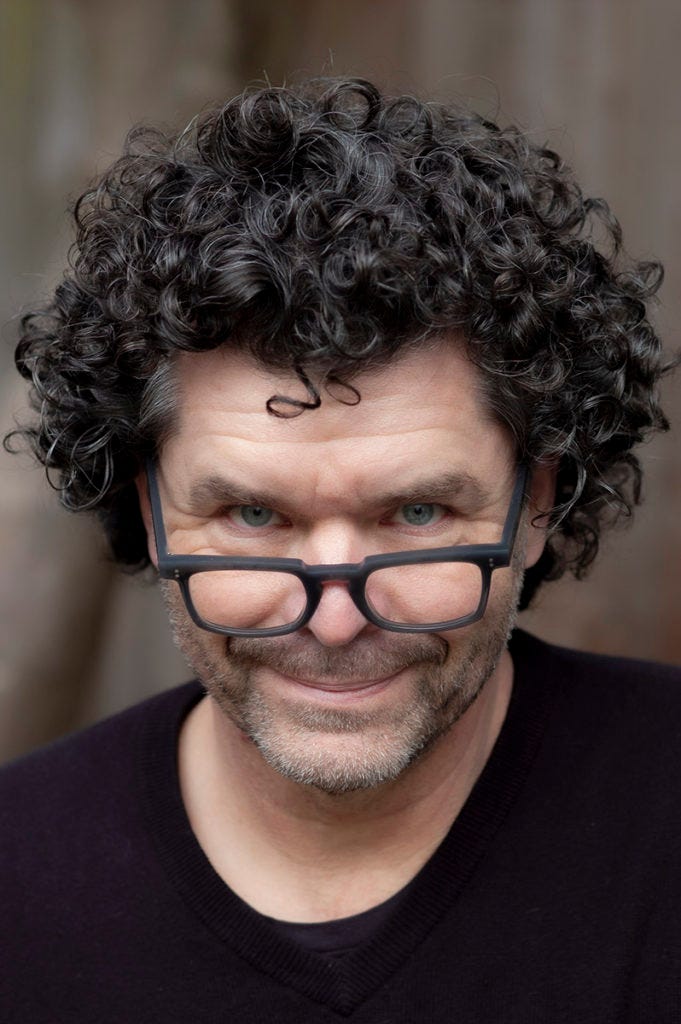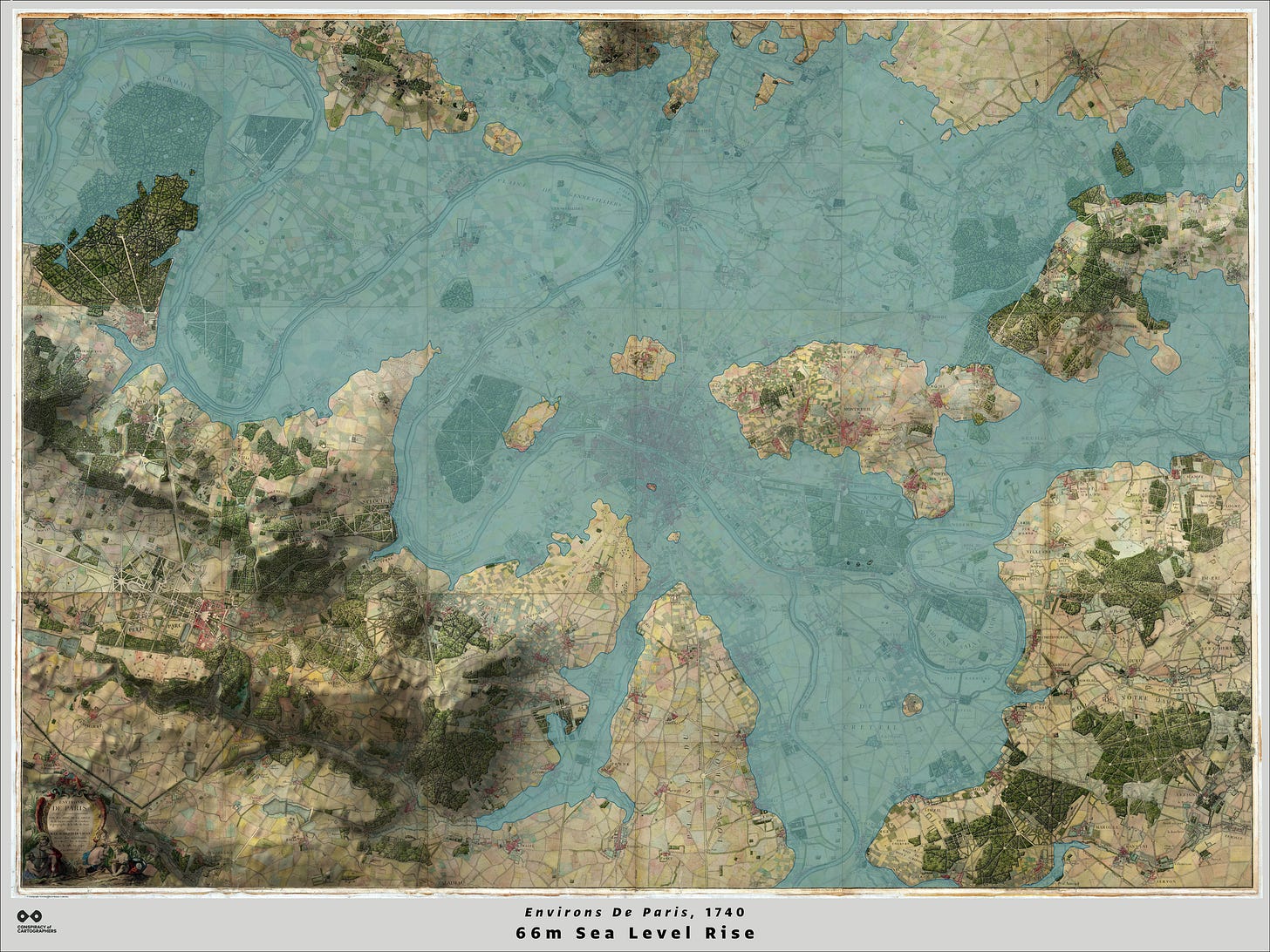Mapping the coastlines of an ice-free planet
Picturing a future we want to prevent
7 minute read
Jeffrey Linn calls himself a speculative cartographer. He creates maps of fantasy worlds for fiction and games. He has also drawn a series of maps for a world we hope will remain a fantasy, where global heating has melted the ice and the sea has risen 218 feet.
Linn’s website, Conspiracy of Cartographers, includes dozens of maps of cities and broader landscapes inundated by vanishing polar ice caps and glaciers, as well as heat-driven expansion of ocean waters. He draws the 218-foot figure from the authoritative Intergovernmental Panel on Climate Change (IPCC). In the maps, much of central Seattle and Vancouver, B.C are island chains. The Columbia Estuary has sunk the flatlands of Portland. Most of what remains are islands. San Francisco Island rises above a greatly expanded bay and drowned delta, which flows toward a Central Valley that has become an inland sea. The maps of Cascadia and Seattle illustrate those changes.

Los Angeles is now the Bay of LA stretching back to the mountains. New York is pretty much gone, though a piece a Staten Island remains. Boston is submerged as well, while the western suburbs have become archipelagos. The Philadelphia suburbs are the new Atlantic coast. London is gorged out by a Thames become a wide ocean estuary.
Linn, a cartographer and GIS analyst whose day job is with the King County, Washington GIS Department, has been drawing his sea-level-rise maps since 2013. His original inspiration came from a sea-level rise map of San Francisco, and even before then from maps of a future California, the Kesh in Ursula K. LeGuin’s Always Coming Home. When Linn did the Portland map, he sent it to her. “I knew she lived in Portland. I got a very nice, warm and generous response from her about the process to make the maps.”
Linn’s maps have been covered in the Washington Post, Foreign Policy, Grist, and the Huffington Post, and even verified by Snopes. Kirk Johnson, Sant Director of the Smithsonian National Museum of Natural History, has used the maps in his presentations.
The mapmaker has cleverly renamed many of the features on the maps. “I really have tried to balance out the horror of what these maps are showing with some levity to make it more digestable for a lot of people,” Linn says. “It’s also fun to go through and rename places. It takes a lot longer to name the places than make the maps, especially if it’s a place I don’t know well. I try to reach into the history of the place, and the perception of the place.”
New York now has a Yankee Aquarium, while the Sea of Caucus sits above where Seacaucus, N.J. used to be. In Seattle, a new Amazon River flows where the company used to have its headquarters, and it’s the Sea Needle now. Vancouver’s West End is now the Wet End. Parts of L.A. become Los Atlantis and Ex-LAX.
“The most fun I had was with L.A. Because L.A. is rich with pop culture references. My favorite name in any of the maps I made was Straits Out of Compton. That’s the peak of my career.”
Because renaming places is so much a part of his work, Linn has been challenged to go beyond the English-speaking world. So he is trying a new tack, layering sea-level rise onto vintage maps. He calls it his retro-future series. Below is Paris.
Linn has also done a retro-future map of Seattle, layering the same new coastlines of the above map onto a 125-year-old chart.
If humanity fails to curb its appetite for fossil fuels, and continues to deforest the planet, how soon could this all happen? Thousands of years? A thousand? Hundreds? Ever? The best answer is, we simply don’t know. What we do know is that scientific models and projections have consistently underestimated polar ice loss. It is moving faster than expected. One of the world’s leading ice scientists, Richard Alley, says a 15-20-foot rise this century is not inconceivable, though standard estimates put it at only three to six feet.
Sea level rise is accelerating. Ocean surfaces are five to eight inches higher now than in 1900. The rate averaged 1.7 millimeters, or one-sixteenth of an inch, over the 20th century. But in the 1990s it sped up to 3.2 millimeters annually, and by 2016 hit a rate of 3.4 millimeters, double the 20th century rate. Based on study of natural records, we know that past sea level was 50-80 feet higher when carbon dioxide was at current levels of 410 parts per million. If CO2 levels remain at that level or go higher, it’s only a matter of time.
The crucial issue is doubling time. Sea-level-rise expert John Englander lays it out.
“Would you prefer to get a million dollars now or one penny the first day with the amount doubled each day for one month? That is, one cent today, two cents tomorrow, four cents the next day, eight cents the day after that, etc. Most choose the one-time million dollars, but are stunned to learn the other offer would total more than 10 times that in just 31 days, for a whopping grand total of $10,737,418. Such is the power of doubling, or exponential growth.”
Englander says the current doubling time could elevate sea levels five feet in 50 years, well above and ahead of IPCC estimates.
However long it might take to reach an ice-free planet, or even just to raise the height of the ocean in ways that completely disrupt human civilization, the key point is that humanity is loading the dice now. Our increasing climate pollution is setting up a momentum that could be impossible to stop. From Antarctica to Greenland, glaciers are melting into the sea at increasing speed. The Thwaites Glacier, which is the “cork in the bottle” for West Antarctic ice, could be near a tipping point. Greenland ice is disappearing at the fastest rate in 12,000 years, and the rate could go up six times this century.
All this says if we want to be remembered as good ancestors, and keep Jeffrey Linn’s maps or something approaching them in the realm of fantasy, we better get kicking on radical reductions in fossil fuel use and deforestation now.
Please subscribe to The Raven or sign up for the free email list here. Your subscription will support my work and help keep access to The Raven free for everyone.





